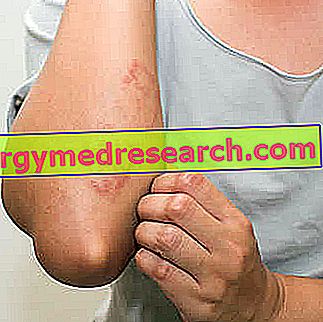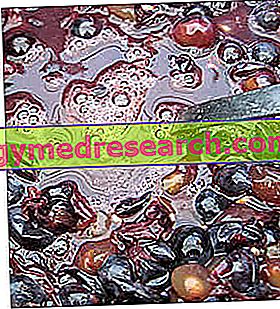Generality
Cutaneous eruptions are visible alterations of the skin, which can arise due to infections, allergies, primary skin diseases, autoimmune diseases, pregnancy, excessive exposure to sunlight, diabetes mellitus, skin cancer, vasculitis, adverse reactions to vaccines etc.

The treatment of rashes is based on the treatment of the triggering causes, whose knowledge requires a fairly accurate diagnostic procedure.
What are rashes?
Rashes, also known as rashes or rashes, are obvious changes in the skin, both in terms of consistency and in terms of appearance, which can sometimes be associated with pain and other symptoms.
Distinctive signs of some pathological conditions and not only, the rashes are phenomena that can affect only some areas of the skin or the whole body.
Causes
The causes of rashes include:
- Infections . Examples of infections responsible for a typical rash are: ringworm, Lyme disease, measles, chickenpox, rubella, scabies, scarlet fever, the fourth disease, the fifth disease, the sixth disease, genital herpes, herpes zoster, infectious mononucleosis, some forms of syphilis, diaper rash, group A streptococcal infections, staph infections, AIDS, impetigo, candida, toxoplasmosis, smallpox, the disease "hands feet mouth", typhus, viral hepatitis, pityriasis rosea, toxic shock syndrome, Kawasaki syndrome, Mycoplasma pneumonia (or atypical pneumonia), rickettsia etc.
- Allergic reactions to medicines, metals, chemicals, lotions, soaps, foods and other materials.
- Primary skin diseases, such as various types of eczema, psoriasis, acne or rosacea. Among these peculiar diseases, the eczema deserve some lines of study.
Also known as dermatitis, an eczema is an inflammatory process on the skin, which causes a rash with particular characteristics.
There are numerous types of eczema, including: atopic eczema (or atopic dermatitis), contact eczema (or contact dermatitis), seborrheic eczema, asteatosic eczema (or xerosis), dyshidrosis, discoid eczema (or nummular eczema), varicose stasis eczema, herpetiform eczema, neurodermatitis and perioral dermatitis.
- Autoimmune diseases, such as systemic lupus erythematosus, scleroderma or ulcerative colitis.
- Diabetes mellitus .
- Pregnancy .
- Skin cancers and tumors in some particular organs of the body that have the peculiarity of altering the appearance of some skin areas.
- Vasculitis, or inflammation of blood vessels.
- Blood circulation problems in the lower limbs .
- Adverse reactions to vaccines .
- Excessive exposure to sunlight .
From the triggering causes the rashes depend on the extension of the latter (so if the eruption is limited to some anatomical areas or the whole body) and the alterations affecting the skin.
Symptoms and complications
The skin subjected to a rash can be the site of:
- Swelling;
- Ache;
- Itch. The itching can be constant (always present) or intermittent (going and coming), acute (ie very intense) or just mentioned etc.
When it is particularly intense, itching can cause the patient to scratch so harshly and repeatedly that he gets cutaneous wounds at risk of infection.
- Blisters. Almost always light in color, the vesicles are small skin lesions (maximum 10 millimeters) and measured with respect to the skin plane, which contain a serous or serum-ematic fluid. They affect the most superficial layers of the epidermis;
- Bolle. Equivalent in all to the vesicles, with the only difference that their dimensions exceed 10 millimeters;
- Pustules. They are skin lesions very similar to vesicles and blisters, which however, unlike the latter, contain pus;
- Colored papules and / or macules. Papules are skin lesions detected relative to the skin plane; the macules, on the other hand, are flat lesions, that is, neither detected nor depressed.
The size of papules and spots varies according to the type of skin rash present (it can go from a few millimeters to even a hundred millimeters).
Papules and spots can be well distinguished from each other or they can appear very closely together (cluster conformation);
- Scales. They are areas of dead cells, which produce dry spots;
- Boils. They are particular protuberances, which arise following the inflammation of bacterial origin of the hair follicles;
- Ulcers. They are deep lesions of the skin, which derive from the loss of epidermis, parts of the superficial dermis and, sometimes, even the deepest layers of the skin.
Skin ulcers are extremely painful and very often do not show a normal tendency to spontaneous healing;
- Changes in normal skin color. Frequent colors of a possible rash are red, bright pink and purple; however, colors such as blue tending to black or yellow are also possible.
In general, changes in the skin color are a prerogative of spots, papules or areas subject to swelling;
- Heat.

Curiosity
In the medical field, infections that, in addition to producing a typical rash, also cause fever, generalized malaise, loss of appetite, headache, abdominal pain and irritability are also known as exanthematous diseases .
The most important and widespread exanthematous diseases are: measles, rubella, scarlet fever, the fifth disease, the sixth disease, chickenpox and the fourth disease.
Other peculiarities of rashes
There are skin eruptions with a contagious nature, which can spread between those who are carriers (the so-called sick) and those who are not (the so-called healthy subject).
These infectious rashes always have an infectious origin. It is therefore impossible, for example, the spread among individuals of a rash from an allergic reaction.
Complications
Contact dermatitis causes rash without complications; intense acne, on the other hand, can cause skin rashes that can lead to the formation of noticeable scars on the skin.
These two examples serve to attest that the degeneration in complications, by a rash, is connected to the triggering factor.
In the most unfortunate cases, skin rashes due to an allergic reaction can culminate in the patient's death.
Diagnosis
The diagnosis of cutaneous eruptions engages doctors not only in finding out the alterations affecting the skin - which, in itself, is quite simple and immediate - but also in the search for triggering causes .
The knowledge of the triggering causes is important, because it represents the basis from which to start the most adequate therapy planning and to achieve a possible recovery.
How to determine the cause of a rash?
To trace the causes of rashes, the following are fundamental:
- In- depth analysis of skin alterations ;
- The anamnesis ;
- Blood and urine tests .
If the information collected during the aforementioned investigations is insufficient or deserves further investigation, the diagnostic doctor may also have recourse to a skin biopsy and instrumental tests such as chest radiography.
ANAMNESIS: WHAT IS THE FORECAST?
For a patient with a rash, the medical history includes a typical series of questions; these questions include:
- How long has the rash been going on?
- Has the rash changed from when it first appeared?
- Does the rash cause itching? If yes, is it intense and unbearable or is it light and intermittent (ie it comes and goes)?
- Has the patient had a fever or has he ever had it since the rash appeared?
- Does the patient suffer from any particular allergy? If so, what?
- Is the patient following any drug therapy? If yes, which drugs are you taking exactly?
- Has the patient recently suffered the bite or bite of any particular insect?
- With the appearance of the rash, did the patient begin to suffer from some other disorder, such as weight loss or joint pain?
CUTANEOUS BIOPSY
The skin biopsy consists in the collection, by means of a very particular scalpel, of a small portion of skin that is interesting from the clinical point of view (such as that in which a rash resides) and in the subsequent microscopic analysis of this cutaneous portion.
Regarding the causes of a rash, the skin biopsy not only clarifies any doubts, but also provides exclusive information, which no other previous diagnostic investigation can guarantee.
Therapy
The therapy of skin rashes varies in relation to the triggering causes. It is quite intuitive, moreover, that a rash due to an infection requires a completely different treatment from a rash due to excessive exposure to sunlight.
It should be pointed out that there are skin rashes due to clinically relevant causes, which deserve timely treatment, since they can also have a fatal outcome for the patient.
Examples of therapy for rashes
- Skin rashes due to a bacterial infection (eg: staphylococcal infection) require antibiotic treatment, that is, based on antibiotic drugs.
The mode of administration of these antibiotics can be oral (compressed) or local (cream);
- Skin rashes due to an allergy require treatment based on antihistamines and, sometimes, corticosteroids .
Antihistamines are drugs that counteract the release of histamine, one of the most important modulators of the inflammatory response and the main cause of allergic reactions. Corticosteroids, on the other hand, are medicines with a powerful anti-inflammatory effect;
- Skin rashes due to eczema require the use of emollients and, sometimes, the use of drugs, including corticosteroids (topical or oral use) and immunosuppressants .
- The rashes due to the presence of diabetes mellitus depend on the treatment of the latter.
Side effects of therapy
Many of the drugs used in the treatment of certain rashes can have unpleasant side effects, especially if their use is improper.
For example, if used inappropriately, corticosteroids can cause obesity, osteoporosis, diabetes, cataracts and hypertension; antihistamines can induce drowsiness; immunosuppressants promote the onset of infections (because they lower the immune system); etc.
Monitoring
During the treatment of rashes, periodic monitoring of the latter is important, because it allows to establish whether the treatment is having the desired effects or not.
Prognosis
Like the characteristics, the complications and the therapy, also the prognosis of the rashes is dependent on the triggering causes; in fact, there are causal factors that can be treated with excellent results (hence the excellent prognosis), causal factors that can be treated with less satisfactory results (hence the uncertain prognosis), causal factors that require continuous treatment (otherwise the rash reappears) and causal factors that respond well to treatment only if the latter are timely.
To understand:
- Treatment of skin rashes due to a trivial staph infection is usually associated with a benign prognosis;
- The treatment of rashes due to diabetes mellitus is effective, as long as it is continuous (diabetes mellitus is a disease that requires constant therapy).
Prevention
The prevention of skin rashes is based, for obvious reasons, on the prevention of the triggering causes.
For example, to prevent rashes due to an allergy, it is essential to avoid the factor that triggers this allergy.



